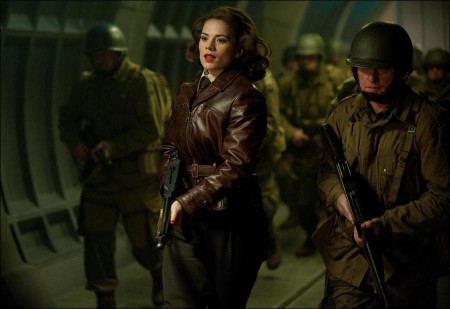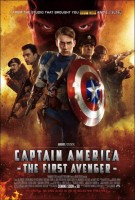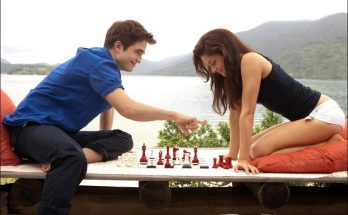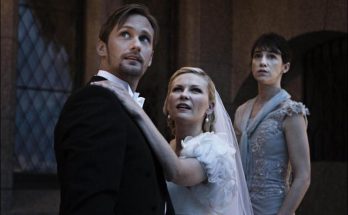Taglines: When patriots become heroes.
Born during the Great Depression, Steve Rogers grew up a frail youth in a poor family. Horrified by the newsreel footage of the Nazis in Europe, Rogers was inspired to enlist in the army. However, because of his frailty and sickness, he was rejected. Overhearing the boy’s earnest plea, General Chester Phillips offered Rogers the opportunity to take part in a special experiment… Operation: Rebirth.
After weeks of tests, Rogers was at last administered the ‘Super-Soldier Serum’ and bombarded by ‘vita-rays.’ Steve Rogers emerged from the treatment with a body as perfect as a body can be and still be human. Rogers was then put through an intensive physical and tactical training program. Three months later, he was given his first assignment as Captain America. Armed with his indestructible shield and and battle savvy, Captain America has continued his war against evil both as a sentinel of liberty and leader of the Avengers.
The Hero That Started It All
Captain America (the Super Soldier alter ego of young patriot Steve Rogers) marked his first Marvel appearance in March of 1941, eight months prior to the U.S. entry into WWII; the unforgettable comic book cover image displayed a young hero, with the American flag on his chest, punching Adolf Hitler square in the jaw. Such an unadulterated political stance landed creators Joe Simon and Jack Kirby in hot water, but it also forever announced the arrival of a bold champion for those suffering at the hands of tyranny and militaristic authoritarianism.
Simon and Kirby made no bones about the super hero’s overriding goal. The staunchly aggressive art created quite a stir, and Simon remembers, “This was the time just before the War, and we were besieged by political activists who used to have big rallies at Madison Square Garden. There would be 50,000 people in the rallies. Some found out where we lived, and these very aggressive people would protest at us and spit on us. The FBI found out what was going on and they assigned agents to be at our offices, just in case.”
(Marvel Studios President and “Captain America: The First Avenger” producer Kevin Feige observes, “When you have Captain America punching out Hitler in March 1941, before Pearl Harbor, it’s definitely a statement, which proclaimed, ‘We cannot sit by on the sidelines anymore.’ That immediately spoke to Steve Rogers and Captain America as a character.”)
Indeed, so imminent was the Axis threat in 1941 that the comic book’s creators worked backwards, beginning with their villain and crafting a hero in response (classically, the hero comes first). Simon and Kirby sat down and designed varying versions of Captain America, finally settling on one in particular that founder Martin Goodman loved (Goodman began Marvel as Timely Publications in 1939). Market response was positive and immediate, and the book started selling out.
Many iterations later, Captain America remains, in many ways, relatively unchanged. Simon comments, “They’ve done a lot of things since I was working on the character, however, we’re still reminded who Captain America is and what he is. He is a symbol. He is an icon.”
It was not until September of 1963 that Marvel Comics debuted The Avengers, a super group comprised of four of Marvel’s most beloved characters: Iron Man, Thor, The Hulk, (all created in the 1960’s) and Captain America, a character created two decades earlier, earning him the title of “The First Avenger.” Since his debut, Captain America comics have sold more than 210 million copies in more than 70 countries. And now, as fans celebrate the 70th birthday of the super hero, Marvel Studios releases the origin story of how Steve Rogers became the first Avenger, Captain America.
Already well versed in successfully adapting graphic novels to films, the Studio remained firm in its decision to keep the story in the era in which it was conceived. Feige states, “It is my belief that we could not have created this notion of an interlinked Marvel cinematic universe without Captain America, because he is the start of the Marvel universe—not only in the history of our comics, but within the overall notion of enhanced humans. Whether that human has been bitten by a spider, exposed to gamma rays, or encased in a self-built metal suit, the notion of a super-powered human started with Steve Rogers, Captain America.”
So, the decision to tell Steve Rogers’ story in the ‘40s era was a done deal. Feige continues, “You can’t tell Captain America’s story without it taking place in that period. Is this the authentic WWII period that you see on the History Channel? Well, no. This film is the history of the Marvel universe separate from the history that we all learned at school—it’s a science fiction approach to history. We’ve taken real life events, real life locations and put the Marvel spin on them, which really gives us the opportunity to explain the origins of the Marvel universe and allows us to tell a story that, frankly, no one else can tell. Plenty of war movies have been made and plenty of WWII movies have been made, but no one has ever made one quite like this.”
Director/executive producer Joe Johnston agrees, and says, “You only really get one chance to do an origin story. The 1940s were such an energetic era, fueled by the optimistic belief that ‘right’ triumphs. Cinematically, it is such a toy box of vehicles, fashion and architecture—and we fill it with the Marvel gadgets and weaponry—it just seemed like a great opportunity to do this story first, then move on.”
The accomplished team of Christopher Markus and Stephen McFeely has been writing scripts for 15 years (including all three of the “Chronicles of Narnia”). McFeely adds, “Captain America is not only such a great embodiment of the American ideal of the time, he also is a prototypical hero—one who wasn’t born to it, but had to work for it—with unwavering courage and belief in himself. Although those things can transfer quite well to modern day, if you have a hero dressed up like a flag, it might be a bit more challenging to accept that in a contemporary context. The fact they wanted to do it right, frankly, made it very appealing.”
In Johnston, Marvel found an ideal director to helm the project. They needed someone who not only wanted to tell the story, but who could also give the story a heart. Johnston began his career early on in special effects, worked at the prestigious Industrial Light & Magic, and shared the 1982 Oscar® for Best Visual Effects for “Raiders of the Lost Ark.” His gifts as a story teller and his familiarity with the technical aspects of bringing a vintage adventure tale to life made him an ideal director for “Captain America: The First Avenger.” Feige remembers, “Whenever we had a conversation with Joe [Johnston], it always came back to the fact he didn’t want to lose sight of the character, didn’t want to lose sight of Steve. Yes, of course, there will be amazing design and a great look, but let’s make sure the audience goes along with him on this ride. He was the right guy to make the story feel contemporary, make it feel modern, relevant and cool for audiences.”
Coincidentally, Johnston had a lifelong fan in Feige, who explains, “I’ve been a huge fan of Joe Johnston almost my entire life, right from his design work on the original ‘Star Wars.’ His career has been leading up to doing a Marvel movie that is cutting-edge, that is contemporary, that has a heart. His film ‘October Sky’ is an amazing, relatable piece of filmmaking. Any other director would come in and want to play, because it’s set in the 40’s and it’s fun, things like that. And that might have left us with something hollow, with the main character coming from a design perspective, and we would have lost the heart of the movie. Johnston, however, was always in sync with the producers and reiterated that the movie had to be about Steve Rogers and his journey.”
As the script began to take shape, screenwriters Markus and McFeely were constantly working to make sure the story of Captain America dovetailed perfectly with the other existing characters and plotlines in the Marvel Universe. Markus says, “We would check in with other projects or they would check in with us, because we wanted to ensure the connective tissue was there—for example, Howard Stark plays a fairly prominent role in our movie, and his son is Tony Stark, Iron Man. The connections have all been there from the start.”
The writers began with the blueprint found on the pages of Captain America comic books. The screenwriters immersed themselves in that world and hungrily pored over stack after stack of issues. In telling the tale from the beginning with Steve Rogers, the story would need to give rise to the entire Marvel universe, a fact that the writers did not take lightly. “We are the midwives who help give birth to this whole thing,” jokes Markus.
“Exactly,” adds McFeely, “there is an organization called the S.S.R. (Strategic Scientific Reserve) in our movie that will later become S.H.I.E.L.D. (Strategic Homeland Intervention, Enforcement and Logistics Division) and you feel very important—in a somewhat unimportant way—to be dealing with the genesis of these well known things that figure so prominently in this universe.”
After some extensive reading of the source material, the screenwriters arrived at the conclusion that the real draw for audiences is the character of Steve Rogers, before he becomes Captain America. McFeely says, “It was important from the get-go that audiences identify with and care for Steve as a character, before he becomes an icon.”
Johnston comments, “We get to know Steve Rogers as a character first—and I think that’s what’s made him such a phenomenon for 70 years. He doesn’t have any super powers per se—his powers are basically what the human body can do, but taken to a level of physical perfection. I have to say, that’s what appealed to me about the character and about doing a film. It’s about a guy who, in a matter of minutes, goes from a 98-pound weakling to the perfect human specimen. As such, Steve has all kinds of issues, both physical and psychological, and it’s very interesting for me to take those issues and explore them in a really good, really fast-paced action story.”
World War II, Marvel Style
Filmed for the most part in the UK, production of “Captain America: The First Avenger” was based at the world-famous Shepperton Studios in Surrey (or ‘Sound City,’ as it was known when productions began shooting there in 1931, a decade before the world was introduced to Captain America). Principal photography began on July 12, 2010 and officially wrapped on November 19, 2010—the shoot employed somewhere in the region of 1,000 crew members. Soundstage shooting was augmented with plentiful location work: in Manchester and Liverpool (North England), Caerwent (Wales, in a former functioning Royal Navy propellant factory), Aldershot (known as ‘Home of the British Army’), Black Park (Buckinghamshire), Hackney Empire (London) and Pinewood Studios (Buckinghamshire).
Even though filmmakers were aiming for the Marvel version of the 1940s, care was taken to keep it grounded in reality. Co-Producer Victoria Alonso says, “We always have a compilation of what was historically accurate, and then we augment as necessary to fit our story.”
Production designer Rick Heinrichs was painstaking in his depiction of locations and history, adapting the British locations into the American settings called for through both practical and computer alterations and additions. Anna Sheppard, who costumed upwards of 300 extras a day for certain scenes, looked to period materials and existing pieces to lend authenticity. Military advisor Billy Budd—with more than 15 years in the British Royal Marines—aided all actors with advice in how to handle military equipment and weaponry; the filmmakers also incorporated actual military personnel in heavy action scenes, with actual or former soldiers comprising about one-third of the on-screen corps. (Budd admits to withholding advice for Evans during his pre-Captain America scenes: “I didn’t want him to have any inkling how to do anything the military way, even come to attention—so he authentically fumbles through a lot of stuff before he becomes the hero he’s meant to be.”) Supervising production armorer Nick Jeffries researched and procured appropriate period guns and instructed actors in their safety and firing. Stunt coordinator Steve Dent also ensured on-set safety during sequences, and helped to create Captain America’s amazing feats of physical prowess, including his high-speed foot chase immediately after his transformation (accomplished with Evans being filmed running while on a ‘magic carpet,’ a treadmill/floor moving at a fair clip).
Training was not exclusive to the male soldiers in the film. Hayley Atwell underwent rigorous military circuit training with an ex-Marine, not only for physical preparedness, but also to handle firing both a pistol and a machine gun believably as Peggy Carter: “The pistol training, I use a Walther PPK, happened quite early on. I’d practiced with a gun before, but nothing ever on this scale. I was really looking forward to it and we filmed some of my training sessions. Then Joe [Johnston], the director, who always liked to have a bit of fun and then see it if he could push it a bit further, said, ‘What if we got you a machine gun? I really think we should make Peggy something special.’ So they brought out this machine gun, and I almost fell over the first time I fired it—it’s so in your face, and there are bits of shells and powder going everywhere, and giving off all this heat. I wondered how I was ever going to do it without flinching. It took a few weeks of being able to fire it without blinking, just concentrating and being able to relax into it. Eventually I was able to feel like it was an extension of my arm. I have to say, in the end, I was rather pleased with myself—but so was Joe [Johnston], and that meant a lot.”
While most of the cast and crew readied themselves to simulate World War II combat, others were tasked with making Steve Rogers look less ready for war. Visual effects supervisor Christopher Townsend was tasked with creating the look of Steve Rogers prior to his transformation. With previous work in fantasy, action and adventure, Townsend came armed and ready for the tasks at hand. Townsend also admits being sold on the job by having been a huge fan of Marvel’s cinematic treatment of “Iron Man.” He admits, “I truly enjoyed the film and quite frankly, it excited me to think what we could do with ‘Captain America,’ especially getting to work on an origin movie and setting the tone for what he’s going to be, what the character’s going to look like and be able to do.”
To convert Evans to the 98-pound Steve Rogers, Townsend employed a collection of visual effects techniques, including head replacement, which was made more believable by ‘thinning’ both Evan’s head and face. A slimmer body double would watch Chris Evans film the scene, then mimic Evans’ performance as closely as possible. Then head and body were married by Townsend’s final magic. Even at 5’7”, the double didn’t always appear ineffectual enough, so software was employed to waste his body somewhat. “Chris Evans has such a phenomenal physique, it seems almost a crime to do that to him,” says Executive Producer Louis D’Esposito, “But you’re going to be shocked to see the results and how the visual effect compliments his performance.”
All during filming, Johnston’s name was bandied about on-set as being an ‘actors’ director,’ which Chris Evans explains: “Joe [Johnston] loves hearing what the actors have to say and he’s always willing to rehearse and talk about scenes. He sits everyone down to have really healthy, collaborative, creative conversations, and you don’t always have that luxury. He also shields you from the hierarchy of who need to give their approval on the most minute detail—you really feel like it’s just you and him and that you’re making an indie film together. Whatever the situation, he’ll make it work and he’ll fix it—and on a film with this much scale, that is massively comforting.”
Kevin Feige is a self-professed and huge comic book fan: “We count ourselves among fans, so we see everything as one and the same. If we’re servicing what they want to see, it’s because we want to see it, too. We know that the cardinal sin is to think that we know better than material that has been around for 70 years. There’s a reason why Captain America is so much older than we are, and he’ll be here long after we’re gone.”
Feige continues, “What’s fascinating about Steve Rogers/Captain America as a character is that he has largely remained unchanged. He is able to adapt to the times and is able to reflect the mood of the country at any given moment. It’s exciting to finally get the chance to tell his story in a big screen adaptation.”
Chris Evans counts himself lucky to be a part of this ‘comic book movie’: “They have a built-in and incredibly loyal fan base. I’m obviously going to take extra precaution with every decision I make in this movie, in order to honor those fans. They have a strong voice and they want to be heard. But that’s a great thing. An actor needs an audience and it’s nice having the fans out there, because you know they’ll support you. With a lot of cooks in the kitchen, it’s tricky to have one vision. It’s not easy, or there would be a lot more of them. I didn’t just do this movie because it’s Marvel, because it has an existing fan base—those were contributing factors. But what sealed the deal was Joe Johnston at the helm and Kevin Feige behind the scenes. So the best I can hope is that I kept my head down and I did my job right.”
For Johnston, getting to direct “Captain America: The First Avenger” was wish fulfillment on many levels. He closes, “I just thought that here was a character that was a projection of a national ideal. Historically, the character came out before we ever entered the War, and I think he quickly became a symbol of ‘here is what we could do if we were allowed to.’ Well, I guess getting to do the film allowed me to do those things. Those national dreams were handed to me, and I think we got to tell Captain America’s story in a way that would make everyone—the fans, the creators at Marvel—proud. I couldn’t be happier.”
Captain America: The First Avenger
Directed by: Joe Johnston
Starring: Chris Evans, Hugo Weaving, Hayley Atwell, Tommy Lee Jones, Neal McDonough, Sebastian Stan
Screenplay by: Christopher Markus, Stephen McFeely
Production Design by: Rick Heinrichs
Cinematography by: Shelly Johnson
Film Editing by: Robert Dalva, Jeffrey Ford
Costume Design by: Anna B. Sheppard
Set Decoration by: John Bush
Art Direction by: Dean Clegg, John Dexter, Phil Harvey, Jason Knox-Johnston, Chris Lowe, Andy Nicholson, Phil Sims
Music by: Alan Silvestri
MPAA Rating: PG-13 for intense sequences of sci-fi violence and action.
Studio: Paramount Pictures
Release Date: July 22, 2011
Hits: 81





